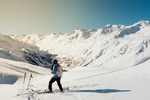

Embarking on your first ski adventure can be thrilling, but without the right gear, it can quickly become uncomfortable—or worse, unsafe. This comprehensive ski essentials checklist is designed to equip beginners with everything needed for a smooth, warm, and enjoyable experience on the slopes.
Below you'll find not only fundamental items like boots and goggles, but also lesser-known yet critical pieces—like specialized ski socks, touchscreen-compatible gloves, and versatile protective hats—all of which make a real difference in comfort and performance.
1. Base Layers: Start with Warmth Closest to Your Skin
Why It Matters: Base layers regulate body temperature, wick moisture, and offer insulation—perfect for layers in cold, high-movement environments.
Essentials:
-
Thermal tops and bottoms made from merino wool or high-quality synthetic fabrics.
-
Mid-layers, such as fleece pullovers or lightweight insulated jackets, for added warmth between your base layer and shell.

2. Ski Jacket and Pants: Your First Line of Defense Against the Elements
Being waterproof and windproof is crucial to staying dry and warm—not to mention comfortable.
Tips for Beginners:
-
Go for 3-layer or 2-layer shells with decent waterproof ratings (≥10,000 mm) and breathable fabrics.
-
Make sure pants have sealed seams, adjustable waist, and boot gaiters to keep snow out.
3. Ski Socks: Often Overlooked but Critical for Comfort
Your feet take a lot of beating—long hours in ski boots, cold temps, and sweaty conditions. Ordinary socks won’t cut it.
Why Upgrade Matters:
-
Look for thick, breathable ski socks with moisture-control fibers and cushioning zones.
Recommended product: Check out these long, warm, breathable ski socks that provide thickness, fit, and thermal insulation—all great for beginners gearing up for their first ski trip.
4. Gloves or Mittens: Keep Your Hands Warm and Functional
Cold hands quickly ruin a great ski day. Opt for gloves or mittens that are warm—but also let you use your phone or adjust settings on your gear.
Look for Features:
-
Waterproof, windproof outer (like synthetic shell or treated fabric).
-
Insulated lining with breathable, soft interior.
-
Touchscreen compatibility—so you don’t have to remove gloves to use your phone.
Recommended product: These thermal touchscreen winter gloves offer perfect weather protection and functional fingertips, ideal for ski beginners who still want smartphone access without freezing.
5. Helmet and Goggles: Safety and Vision First
Your head and eyes deserve top-tier gear on the slopes.
Helmet:
-
Must fit snugly yet comfortably.
-
Ideally certified to AST or CE standards and ventilated.
-
A helmet with adjustable vents helps regulate temperature.
Goggles:
-
Choose double-pane, anti-fog lenses for clear vision.
-
Pick colors suited to your typical conditions (e.g. low-light vs sunny).
-
Get those with wide peripheral vision and comfortable foam padding.

6. Ski Hat or Beanie (Under-Helmet) for Added Warmth
Even with good headgear, wearing an insulating hat under your helmet is smart—especially on bitter cold mornings or wind-dazed afternoons.
Recommended product: Try a 3-in-1 fur-lined trapper bomber hat. It’s multifunctional—covering your head, ears, and even face. Wear it pre-ride, post-ride, or during breaks for cozy warmth.
7. Neck Gaiter or Buff: Shield Your Neck and Face
Cold and wind-chill can penetrate the vulnerable neck area. Buffs offer versatile protection.
Features to Look For:
-
Thermal fabric or fleece lining.
-
Seam-free design for comfort under helmet and jacket.
-
Tube or balaclava styles for full coverage of mouth and nose.
8. Ski Boots: Comfort and Performance Start Here
Renting is an option, but owning your own pair ensures proper fit and support.
Key Fit Tips:
-
There should be minimal toe movement when the boot is bent forward.
-
Liner should feel snug yet not cut off circulation.
-
Temperature-moldable liners provide better comfort and control.
9. Ski Poles: Balance, Rhythm, and Control
Poles help stabilize turns and aid in lift-area navigation.
Choosing Tips:
-
The correct length puts your elbow at 90° when the pole is upright.
-
Durable materials like aluminum or carbon for longevity.
-
Comfortable grips and adjustable straps for control.

10. Ski Pants—Maintain Dryness and Movement
Your legs need protection from snow, wind, and the rare tumble.
Recommended Features:
-
Waterproof rating of at least 10,000 mm.
-
Articulated knees and ventilation zips for mobility and temperature control.
-
Reinforced cuffs resist wear from skis or poles.
11. Safety Gear & Accessories Every Beginner Shouldn’t Skimp On
Even if staying in reserved areas, having basic safety equipment builds good habits.
Essentials:
-
Avalanche safety kit (if venturing off-piste): beacon, probe, and shovel.
-
Small first-aid kit with blister pads, pain relievers, and basic wound care.
-
Ski lock for securing gear during breaks.
12. Backpack with Hydration and Snack Compartment
Keep essentials, like water, snacks, extra gloves, or lip balm, easily accessible.
Smart Backpack Features:
-
Waterproof or water-resistant material.
-
Dedicated compartments for hydration tubes.
-
An internal fleece pocket for goggles or phone.
13. Ski Wax and Tuning Tools: Keep Your Gear Gliding Smoothly
Not mandatory for a beginner, but having basic waxing tools ensures consistent glide and ease in skiing.
Essentials:
-
Glide wax for your ski base.
-
Soft roller or iron for wax application.
-
A base scraper or brush for smooth finishing.

14. Sunscreen and Lip Balm: Don’t Forget the Skin Protection
Snow reflects UV rays intensely, increasing burn and wind-irk exposure.
Dermatological Must-Haves:
-
SPF 30+ sunscreen for exposed areas.
-
Tinted or clear lip balm with sun protection.
15. Protective Eyewear (Sunglasses) for Post-Ski Breaks
Your goggles are invaluable—but it’s wise to carry backup sunglasses for off-slope time, navigating around lodges or sunny terraces.
Sample Ski Essentials Checklist Table
| Category | Item Description | Notes |
| Base Layer | Thermal shirt and pants | Moisture-wicking, breathable fabric |
| Mid-Layer | Fleece or insulated top | Adds important warmth |
| Shell Layer | Waterproof jacket & pants | Needs zipper vents and gaiters |
| Socks | Warm, breathable ski socks | See product link above for recommended pair |
| Gloves | Touchscreen thermal gloves | Keeps hands warm and functional |
| Hat | 3-in-1 trapper bomber hat | Covers head, ears, face—very versatile |
| Helmet | Well-fitting, certified | Safety first |
| Goggles | Anti-fog, double lens, wide view | Clear vision is crucial |
| Buff/Gaiter | Thermal neck protection | Wind and cold shield |
| Boots | Properly fitted ski boots | Comfort equals control |
| Poles | Size-appropriate ski poles | Great for rhythm and turns |
| Backpack | Waterproof, compartmentalized | Carry essentials securely |
| Waxing Tools | Ski wax kit + scraper | Helps maintain smooth glide |
| Safety Kit | Beacon, probe, shovel (for off-piste) | Essential for advanced skiing |
| Eyes & Skin Care | Sunscreen, lip balm, sunglasses | SPF protection is non-negotiable |
| Tunes & Comfort | Base tuning tools, optional hand/feet warmers | For extra luxury and maintenance |
Final Thoughts: Preparing for Your First Ski Trip
For beginners, skiing should be about fun, not discomfort. Investing in the right ski essentials sets you up for success. Critical items like warm ski socks, touchscreen gloves, and a 3-in-1 thermal trapper hat elevate your experience—not just in warmth but in convenience and safety.
Start layering from your base up, prioritize visibility and protection, and don’t be afraid to invest in comfort—because a happy skier is always a better skier.
Blog posts
-

, by pangXILONG Cute and Funny Halloween Costumes for Kids and Pets
-

, by pangXILONG Home Workout Safety Guide: Using Ab Wheel Foam Rollers 1kg Dumbbells Pedal Bands
-

, by yufanjiang Kitchen Chapter: How to Bid Farewell to Clutter and Create a Kitchen with High Aesthetic Standards



